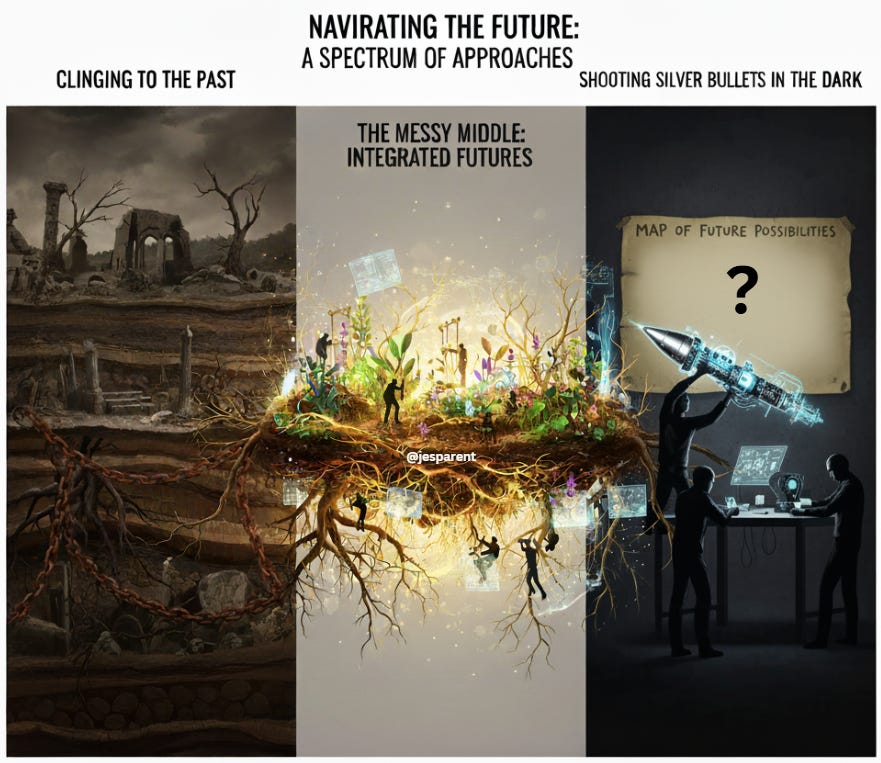Old Clout, Dead Maps, and the Illusion of Rigor
A brief airing of grievances about some trends in the futurist camp.

There’s a type of intellectual recycling I see happening a lot lately—especially in spaces that endeavor to be “future-facing.” It’s the re-use of outdated clout, the repackaging of old status systems, and the subtle assumption that we can build a new world using blueprints designed for a very different one.
My hot take? This isn’t rigor.
It just feels like rigor—because it’s familiar. It’s structured. It has a paper trail. But it’s not truly forward-thinking. It just appears easy.
And easy is what got us here.
Let me be clear: understanding the past is indispensable. We need to reckon with
the history of power, clout, and exclusion—especially in tech, academia, and politics. But that reckoning cannot be the final act. If we stop there, we’re not building a bridge to somewhere. We’re just polishing the ruins.
Perfect recitation of scriptures is not the same as participating in the journey to somewhere new
True innovation means juxtaposing our understanding of what has been with a bold vision of what could be—especially when it centers the people, insights, and values that legacy systems have overlooked or silenced1.
I’m not interested in being a gadfly or critic as my main role, but this post is essentially public therapy about something I am repeatedly exposed to on various fronts. When I see respected institutions and leaders still clinging to the same playbooks—while claiming to “lead the future”—it’s hard to stay quiet.
So, here’s the question that keeps gnawing at me:
Why do we keep needing to re-learn the same lessons from 40, 60, 100, 200+ years ago?
Some people shrug and say: “That’s just human nature.”
But I don’t buy it. I think we’ve not risen to the challenge, culturally and strategically, to cultivate better options—to show that something else is possible2.
Too many people haven’t seen a viable alternative to the status quo.
Worse, they don’t even know why those alternatives haven’t emerged.
This isn’t just a leadership problem. It’s a design problem.
And it’s one worth solving.
Because building a future worth living in isn’t about being clever with yesterday’s clout. It’s about being courageous with today’s possibilities.
As always, views are my own.
Jes - Boston, September 2025
So the question is, how do we juxtapose, how do we make informed alternatives? How can we sort out what is too far to either side of the spectrum? This is what I’m hoping to build tools, strategies, and playbooks around in a new program.
I’m aware of my position here. For many people, brushing up against broken systems isn’t optional—it’s a constant, lived experience. My exposure is elective. But the fact that I have that choice makes the work no less necessary. If anything, it makes the silence louder.


Chasing legitimacy and clout is NOT the problem in my eyes, fwiw. It's the lack of critical literacy and intentionality about where clout structures can or should shift to. It's related to "Expert Writing" in the classic Larry McEnerney sense; the work of right now is how to train people to be rigorous and shift the expert circles McEnerney talks about. But the longer term plaining and aiming for where and how to change those structures seems lost, or, just relegated to 'wishful thinking' and something we can't talk about because the world is on fire in 2025, and we'll "come back to it later." I don't think it's going to wait for us.
Times are changing. I've been exposed to a lot of clout-reaching and legitimacy-hoping that continues to fall increasingly flat. As builders, teachers, educators, and empower-ers-of-others-doing-the-work, I think we need to center this topic, or at least be aware of it as we help folks transition to dealing with 2025, and prepare for 2026, 2027, and the critical decade ahead.